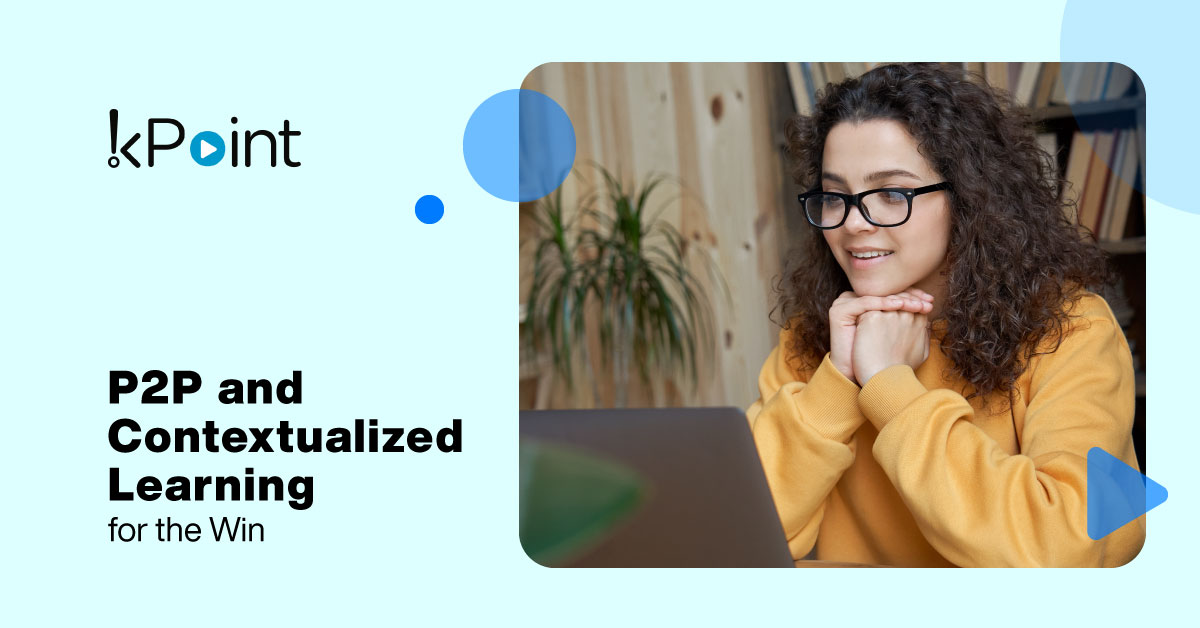
Social learning is among the most effective methodologies to improve knowledge absorption and retention. And, the chances are that your employees will engage in social learning anyway, formally or otherwise. Research suggests that it could account for 75% of the knowledge obtained in the workplace, with 45% happening informally on the job. By incorporating a video-enabled social learning strategy in corporate L&D, you can gain from human beings’ inherent behavioral tendency of learning from each other – and amplify the outcomes using next-gen technology.
What Is Social Learning?
Social learning is a theory in pedagogy that suggests that human beings can acquire new skills, knowledge, and behavioral habits by observing, imitating, and interacting with others.
It is proven to be much more beneficial than independent or isolated learning in most use cases. For instance, academic research indicates that social learning aided by analytics can significantly improve outcomes in online environments. Social learners are also more likely to view and consume learning content than their independent learning counterparts. In fact, social learners view up to 37% more content on an average, which aids in learning progress and course completion rates.
This has the following benefits for an enterprise:
- Greater adoption of e-learning content, driving more ROI
- A learning culture as employees engage in a shared learning experience
- The ability to collaborate as you learn and apply the skills to real-world tasks
- Wider reach of your L&D programs and an overall cost reduction
Video content is a key element of social learning as it is among the fastest and most engaging ways of information dissemination.
Video and Social Learning: A Force-Multiplier for L&D
Video is among the top preferred ways to learn new things among employees, particularly millennials and Gen Z. 75% of employees would rather learn from a video than read text and millennials are 2.7 times more likely to learn a new skill from videos than a book. This makes videos uniquely suitable for outcome-focused L&D programs, and it is a perfect match for social learning strategies – for three reasons.
First, creating video learning content like a quick explainer or a slideshow-based quiz is much faster than putting together a comprehensive document or e-book. Employees are also more likely to watch the whole thing than they are to pursue written documentation in detail. Second, videos are easy to share and comment on, inviting multiple perspectives from different viewers. This fosters an engaging social environment. Finally, employees can share what they have learned through self-recorded videos that can inspire and help others, which is the primary aim of social learning theory.
Best Practices to Leverage Video for Social Learning Experiences
Importantly, adoption by employees is the no.1 challenge when implementing social learning, faced by 53% of companies. Video addresses this to a significant extent as there is already widespread demand among employees and the format is acutely tuned for current and future generations. Here are five best practices that can help you maximize the potential of video for social learning experiences.
1. Use a video platform that supports shareability, searchability, and collaboration
Employees must be able to look up learning videos and share them with colleagues. They also need to collaborate in the context of the video, so they can directly apply the knowledge obtained to the task at hand. Select a video management platform that has advanced search, which looks through the content of the video itself in addition to the title and metadata. There should be clear and easy-to-access buttons for peer-to-peer sharing and the ability to comment.
2. Integrate video learning content with business applications
This is a key trait of social learning in an enterprise. The learning content must be available exactly in the context of work and collaboration, and you can achieve this through intelligent integrations. Connect the platform where your video learning content is hosted with the business applications regularly used by employees. This could include customer relationship management (CRM) systems, unified communication (UC) systems, and even chat portals so that videos can be sent as messages.
3. Build a microlearning strategy to intersect content with the flow of work
Continuous learning is a crucial aspect of a social learning experience, where content consumption happens in a bite-sized and a contextualized manner. You need a robust microlearning strategy to be able to achieve this. Identify topics that require bite-sized video explanations. Leverage a user-friendly editing tool to generate a high volume of short videos that are available on demand.
4. Analyze learner progress to drive gamification
Gamification and social learning go hand in hand. Encouraged by healthy competition, employees try to beat their own and their peers’ milestones, which amplifies learning outcomes. You can set up video business intelligence (BI) to track learner progress, highlight top performers, and reward goal completion. Gamification also aids in strengthening peer-to-peer relationships, which further positively influences the social learning experience.
5. Empower learners to create and share their own video content
Finally, employees must be able to create and share their own learning videos (either pre-recorded or via live events/webinars) to inform and inspire others in the organization. This also adds to your microlearning video repository, ensuring that it is comprehensive and spans every possible topic relevant in the context of work.
How kPoint Can Help
kPoint provides organizations with a cloud-hosted video management platform that’s tailored to your social learning requirements. With features like advanced search, in-video navigation, API-based integration, and learning analytics, you can develop a learning culture where employees are not only compelled to learn as part of their professional journey but feel inspired to do so in a collective and socially enriching environment.
Do you feel video-enabled social learning is a good fit for you? Contact our experts for a personalized roadmap.

